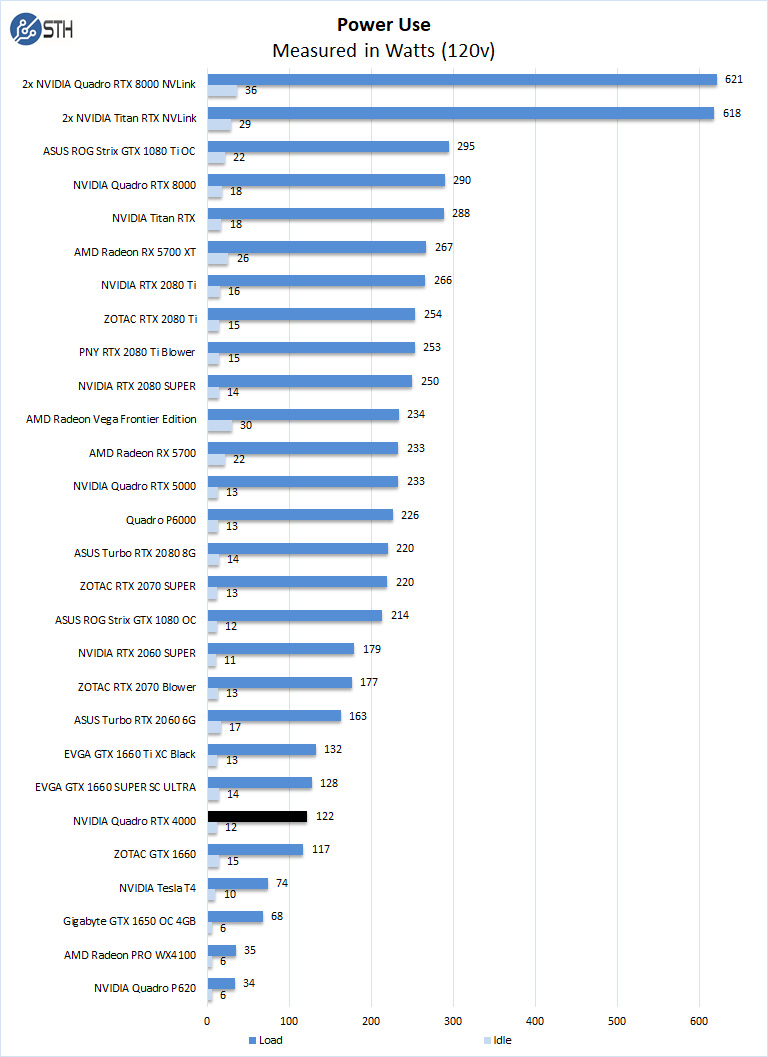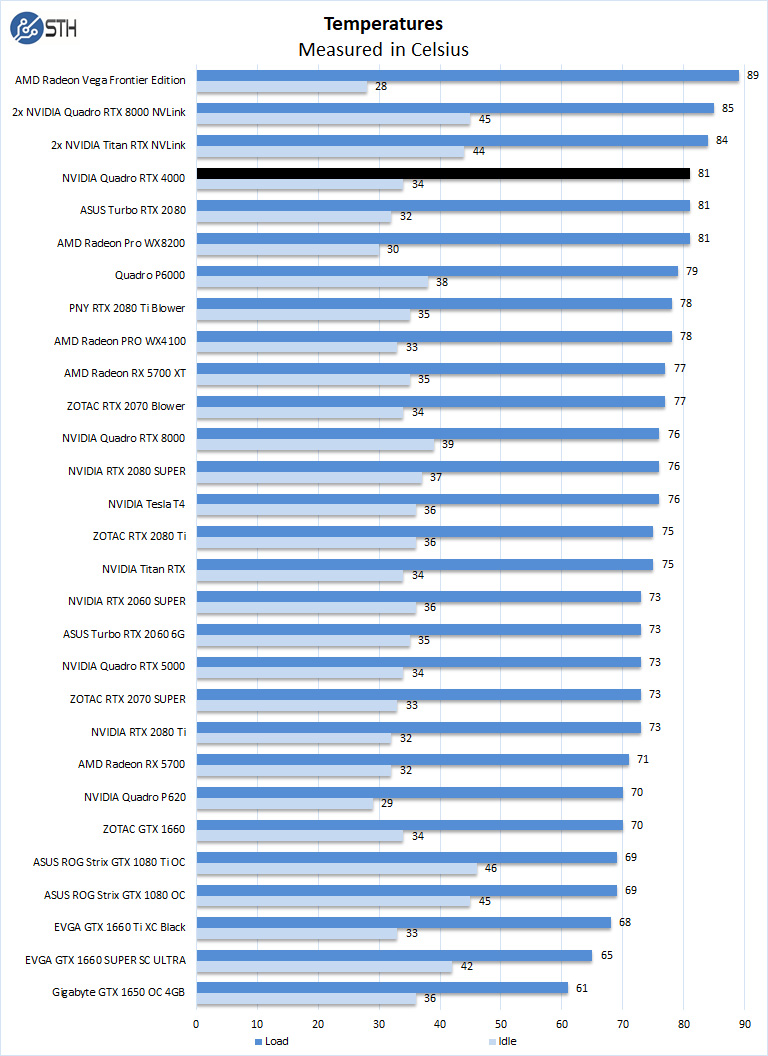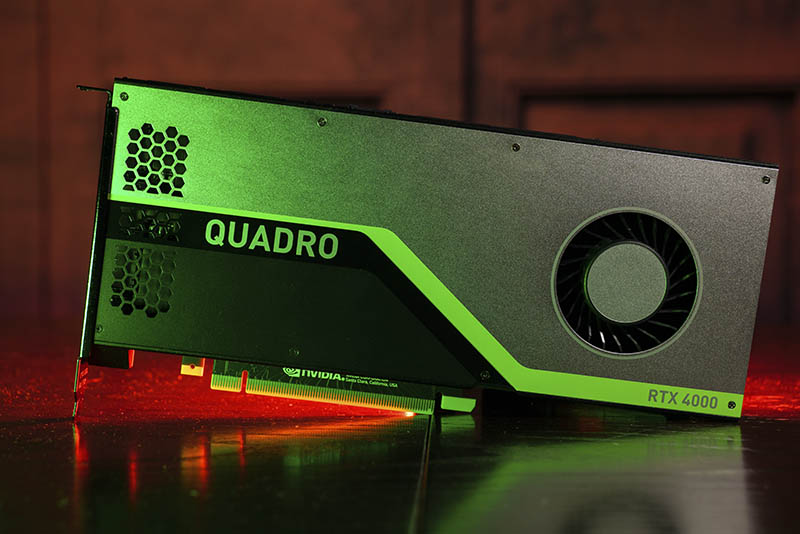Power Tests
For our power testing, we used AIDA64 to stress the Quadro RTX 4000 configuration, then HWiNFO to monitor power use and temperatures.

After the stress test has ramped up the Quadro RTX 4000 configuration, we see it tops out at 122Watts under full load and 12Watts at idle. This was quite a bit lower than the 160W advertised on the spec sheets. It is also less than twice what we see for the NVIDIA T4.
Cooling Performance
A key reason that we started this series was to answer the cooling question. Blower-style coolers have different capabilities than some of the large dual and triple fan gaming cards.

Temperatures for the Quadro RTX 4000 ran at 81C under full loads, in this case, the highest temperatures we saw achieved while running OctaneRender benchmarks. Idle temperatures were reasonable at 34C. We can see that there are some cooling limitations to the single-slot cooler design. Perhaps this is nearer to the edge of what a single slot blower-cooler can achieve.
Final Words
There is a lot to like about the Quadro RTX 4000. It is a single-slot, low power graphics card that packs a serious punch. The Quadro RTX 4000 competes against the GeForce RTX 2070 and sometimes higher graphic cards in many of our benchmarks.
If you are looking at light to medium AI projects, the Quadro RTX 4000 will serve you well. Inferencing projects often do not require high-end GPUs, and with the Quadro RTX 4000 with its single-slot design, one can fit up to seven in a large workstation/server to split these inferencing loads across different GPUs. We were surprised by how well these cards perform compared to the T4. While the NVIDIA T4 has a better form factor for servers and edge deployments, this Quadro’s performance is going to intrigue some.
This excellence in compute and inferencing makes a lot of sense for the Quadro RTX 4000. More professional content creation applications are being optimized for utilizing the AI inferencing capabilities of NVIDIA’s newer architectures. As this happens, there will be greater divergence between GPUs with and older GPUs without hardware AI inference acceleration.

Running multiple workloads across several GPUs is not always practical. There is still a good reason to scale up GPUs to the NVIDIA Quadro RTX 5000 or going to much larger dual NVIDIA Quadro RTX 8000 or NVIDIA Titan RTX configurations. We know STH readers want to see GeForce RTX 3090 results. Those are coming soon, but the RTX 4000’s form factor and power consumption put it in a completely different league compared to the RTX 3090.
Pricing for the Quadro RTX 4000 is just under $900, which is a sweet spot for a Quadro class GPU. This seems expensive if you are accustomed to GeForce pricing, however, compared to the software licensing and other hardware that is used in the professional content creation market the Quadro RTX 4000 is relatively inexpensive. Overall, this is certainly a GPU we wished we had looked at earlier in its product cycle.
As a quick note here, STH recently Confirmed NVIDIA Quadro Branding Phased Out for New Products. Prior to publishing this article, we reached out to NVIDIA and asked about this existing product since Quadro was clearly emblazoned on the unit. NVIDIA told us it was proper to use Quadro on the RTX 4000 so that is a slight difference compared to how the Tesla T4 to T4 transition was implemented.




The Quadro RTX 4000 has served me well at work in an external Thunderbolt GPU chassis as a portable production GPU. It is an interesting use case as the raw GPU performance was not as critical as getting several check boxes marked on the feature set which precluded many of the lower end Quadros and made anything higher end pure overkill.
One of the requisite features was support for the Quadro Sync II board so that it can be gen-locked with various video production equipment. Since the Quadro RTX 4000 is a single slot board, the Quadro Sync II card fit in with the external GPU chassis. Note that the gen lock board can mount into a PCIe slot, all communication with the GPU card is done via ribbon cables. In a small tower system, I’ve rigged up the same genlock board inside a front panel bay to save on slot spacing.
One of the more interesting things I’ve recently tested has been with nVidia voice where this graphics card get pulled in to do some audio processing in recent months.
The one thing on my wish list for any future nVidia A4000 replacement card would be include Thunderbolt 4 ports on the GPU itself instead of Virtual-Link. It’d be far more useful and there are a handful of video production boxes with Thunderbolt 3 interfaces that could hypothetically communicate directly with the A4000’s hardware video encoders, reducing latency for real time encoding by a few critical hairs. Similarly, an HDMI 2.1 port would be valuable for the video production area that I’ve been involved in lately as a DisplayPort to HDMI adapter would not be necessary for display. Though for a multidisplay system where timing is critical, having all the ports leveraging the same adapters does equalize time vs. one native HDMI port and multiple DP ports with active adapters.
I have installed the NVIDIA RTX 4000 on my Intel s2600stbr motherboard with 256GB ram and two 10 core intel Xeon silver 4210 CPUs with windows 10 pro for workstations, and got the message after compatibility check that due to programs running in the background or OS incompatible, can anyone help with this.
I have an RTX 4000 in my Dell Precision T7610 with two 10 core Xeons and 128gb RAM. Very strangely the machine totally refused to boot up with the RTX card in the PCI-E 16x slot that in intended for the GPU card, so I removed it and put it in the lower PCI-E 16x slot and it’s fine. Bit weird but there we go.
It runs hot. Even with the case fans running fairly energetically it was in the 80’s on full load. I’ve put a slot-fan both above and below the card forcing more air to blow all over it and it’s shaved about 10 degrees off, much better. But now I’m using three slots for a single slot card, which defeats the object somewhat!
Lovely card though.